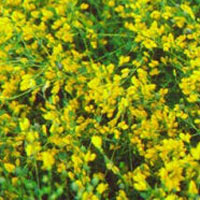Penn Herb Wellness Guide
Wild IndigoFind Products
 © Steven Foster
© Steven FosterParts Used & Where Grown
The plant is native to the midwestern United States and continues to grow primarily in this region. The root of wild indigo is used medicinally.
- Reliable and relatively consistent scientific data showing a substantial health benefit.
- Contradictory, insufficient, or preliminary studies suggesting a health benefit or minimal health benefit.
- For an herb, supported by traditional use but minimal or no scientific evidence. For a supplement,little scientific support.
Our proprietary “Star-Rating” system was developed to help you easily understand the amount of scientific support behind each supplement in relation to a specific health condition. While there is no way to predict whether a vitamin, mineral, or herb will successfully treat or prevent associated health conditions, our unique ratings tell you how well these supplements are understood by the medical community, and whether studies have found them to be effective for other people.
For over a decade, our team has combed through thousands of research articles published in reputable journals. To help you make educated decisions, and to better understand controversial or confusing supplements, our medical experts have digested the science into these three easy-to-follow ratings. We hope this provides you with a helpful resource to make informed decisions towards your health and well-being.
This supplement has been used in connection with the following health conditions:
| Used for | Amount | Why |
|---|---|---|
Common Cold and Sore Throat | Refer to label instructions | Wild indigo appears to stimulate immune function and is considered a strong antimicrobial agent. In tinctures with echinacea, boneset, white cedar,and homeopathic arnica, it also has prevented and reduced colds.
|
Infection | Refer to label instructions | Wild indigo is both immune supportive and antimicrobial. |
Influenza | Refer to label instructions | Wild indigo contains polysaccharides and proteins that have been reported to stimulate the immune system. It is often used in combination with herbs such as echinacea, goldenseal, or thuja. |
Traditional Use (May Not Be Supported by Scientific Studies)
Historically, the root of wild indigo was used to make blue dye. It was also used by European herbalists to treat ulcers and several types of infections, including those affecting the mouth and gums, lymph nodes, and throat.1
Copyright 2026 TraceGains, Inc. All rights reserved.
Learn more about TraceGains, the company.
The information presented by TraceGains is for informational purposes only. It is based on scientific studies (human, animal, or in vitro), clinical experience, or traditional usage as cited in each article. The results reported may not necessarily occur in all individuals. Self-treatment is not recommended for life-threatening conditions that require medical treatment under a doctor's care. For many of the conditions discussed, treatment with prescription or over the counter medication is also available. Consult your doctor, practitioner, and/or pharmacist for any health problem and before using any supplements or before making any changes in prescribed medications. Information expires December 2026.


